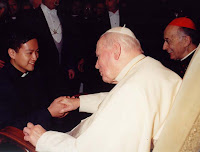 I have branded the trip “exhausting, terribly lengthy, hassle-filled”. And indeed, I had reason to do so, and still it would be an understatement.
I have branded the trip “exhausting, terribly lengthy, hassle-filled”. And indeed, I had reason to do so, and still it would be an understatement. Our ordeal began with the usual rituals that we do in airports, on the early morning of Sunday, August 19. Fr. Paul, Fr. Mike and myself were brought to the airport from Don Bosco Makati. The ticket and passport check, the baggages through the X-ray machines, the walk through the metal detector (they didn’t detect my braces!), the checking in, the airport fee, the immigration officer, the X-ray part 2, the body check, and the dull span of time before boarding the plane.
Our flight was supposed to be 10:45am: KLM Manila-Amsterdam-Zurich. The plane was there but there was no sign that we would board. Then it was announced: the flight was cancelled due to engine trouble (another long story told to us which I would skip). We were billeted at the Manila Hotel. We have lost a day.
The next day at the counter we were told that there would still be no flight. After some intercessions from people connected with the airlines as well as some persistence from us, we left Manila on August 21, 12:20am: Korean Airlines-Air France with a new itinerary: Manila-Seoul-Paris-Zurich—a long trip of about 24 hours including the stopovers.
We reached Zurich at 7:00pm of August 21. It was the longest trip I’ve had so far in my life. If we counted since Sunday (with the limbo at Manila Hotel), it would come up to more than two and a half days. We stayed the night in Zurich with Fr. Johan Dumandan and a Filipino family as our gracious hosts. Exhaustion set in as we began to lose the adrenalin that powered us the preceding days.
The long trip to Leysin resumed yesterday morning with our train trip from Zurich. It extended to more than three hours: Zurich-Lausanne-Aigle-Leysin. And what a trip the last leg was. It was an ascent that was rewarding: very pleasant weather in a scenic village among the Alps: the destination a real consoling blessing. Thus is life: through adversity to glory.




